Perched atop the Western Ghats in the Idukki district and located near Munnar, Kanthalloor is known locally as the Kashmir of Kerala.
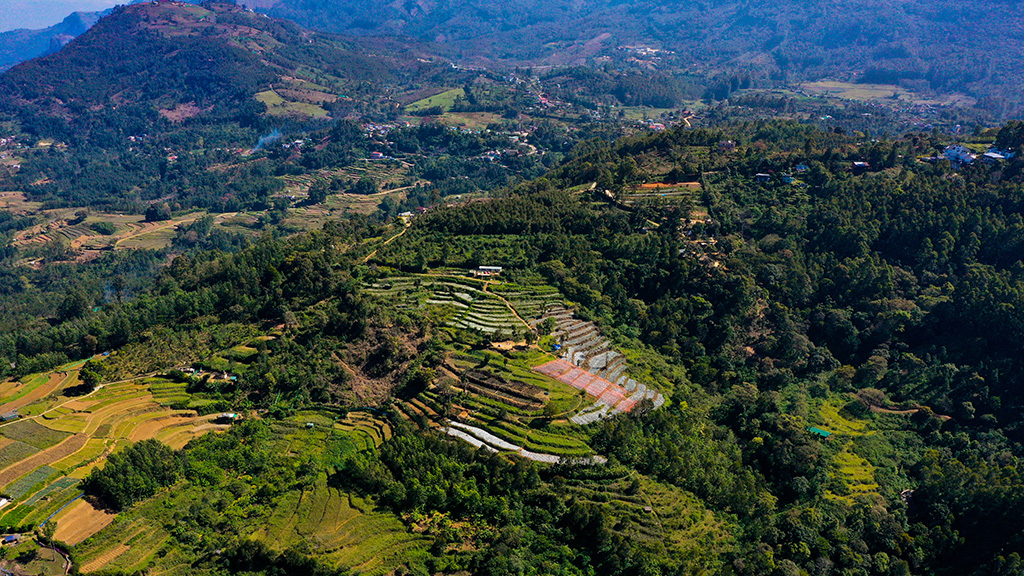
An aerial view of kanathallur village nestled on top of Western Ghats in Idukki. Photo: Kerala Tourism.
Have you ever thought of the possibility of plucking glistening apples straight from the trees, and that too in a high-altitude village in Kerala, where a salubrious climate and immense eco-tourism possibilities are available?
Perched atop the high ranges of the Western Ghats in the Idukki district and located hardly 49 km from the famous tourism hotspot Munnar, Kanthalloor is known locally as the Kashmir of Kerala.
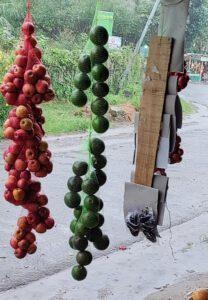
Locally grown apples are on waiting for buyers at a Kanthallur shop. Photo: K A Shaji
An extended part of Marayoor, which houses the largest dedicated reserve for sandalwood in India, Kanthalloor is the lone place in Kerala where apples are cultivated along with oranges, strawberries, blackberries, plums, gooseberries, egg fruit, peaches, sugarcane, and passion fruit.
It also has extensive agricultural fields, where cauliflower, cabbage, carrots, beans, potatoes, and garlic grow.
This is the only village that grows such a combination of vegetables in Kerala; most are normally procured by the state’s people from outside.
Though the apples turn ripe by July every year, orchid owners let them be in the trees till the Onam festival season, when visitors throng the mist-clad village to pluck the fruit directly from the branches.
Most of the fruits of the village are sold to interested visitors directly from the farm without involving intermediaries.
Kanathalloor, Maryur, and the adjacent Chinnar Wildlife Sanctuary constitute a rare experience for visitors.
Accessible easily from Tamil Nadu’s Udumalpet, the twin tourist villages are wooing domestic and foreign tourists on a large scale through their unique cultivation.
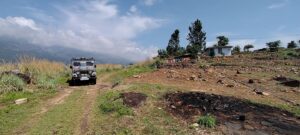
A rural road between Kanathallur and Marayur. Photo: K A Shaji
In Marayur, the gateway to Kanthallur, there are numerous sugar cane fields — another rarity in Kerala.
They contribute significantly to the production of the world-famous Marayur jaggery, dark brown sugar balls made of condensed sugar cane juice.
Manufacturing units are set up inside the sugar cane farms, and the jaggery is manufactured by the farmers, mostly of the local Muthuvan tribe.
The unique geographical location of Marayoor, which is located amid the evergreen forests of the Western Ghats, provides the sugarcane with a distinct geographical identity.
Added to this, the age-old specialised skill of the local people in making the jaggery on the farm makes it a different kind of product in terms of taste and quality.
As a result, they are in great demand across the country for preparing sweet dishes.
The Marayoor Sandalwood Reserve is spread over 1,460.77 hectares and is managed by Kerala’s Forest Department. The reserve has 57,000 such highly-priced trees, with an estimated value of ₹3,000 crore.
The Forest Department allows visits to the reserve and facilitates buying original sandalwood products at an affordable rate.
A repository of biodiversity, the Chinnar Wildlife Sanctuary is home to the great grizzled squirrel of India. Numbering less than 200, they are among the most endangered species on the planet.
In September last week, Kanthalloor created national headlines when the Union government gave it the “Gold”‘ award in the Best Rural Tourism Projects category.
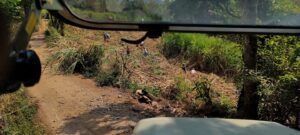
A sugarcane field on the Kanthallur-Marayoor route. Photo: K A Shaji
Kerala Tourism Director PB Nooh, who received the award on behalf of the panchayat in New Delhi, told South First that the honour acknowledged the responsible tourism practised by Kanthalloor, Marayoor, and Chinnar, causing no damage to the environmental equilibrium.
The ethnic and sustainable tourism had finally won recognition, he said.
Kanthalloor was selected for the honour after an eight-month-long extensive evaluation of rural village projects in the length and breadth of the country, said Nooh.
Overall, 767 projects from around the country vied for honours: Five won “Gold”‘, 10 were selected for “Silver”, and 20 for “Bronze”.
According to Kanthalloor Village Panchayat President PT Mohandas, Kathalloor is the country’s first panchayat to implement women-friendly tourism, for which several training programmes were held in collaboration with UN Women.
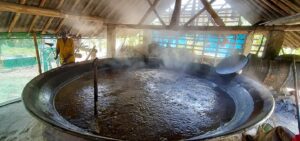
The Marayur jaggery under preparation. Photo: K A Shaji
The “destination security” scheme was implemented, and special women’s tour packages were drawn up.
Other activities like proper maintenance of street lights, public water vending machines, and destination signboards were done.
The collection of waste from houses and tourism properties was systemised.
Green check posts were set up in the village to implement a ban on plastic material.
“Though little known outside Kerala, Kanthalloor and Marayoor promise a different experience through their pleasant climate and sprawling fields of vegetables and fruits. With its long green tracts of land and hills, valleys, orchards and farms, the village easily attracts the delight of Nature lovers and tourists,” said Shalini Binu from Thiruvananthapuram, who operates an eco-tourism resort in the locality.
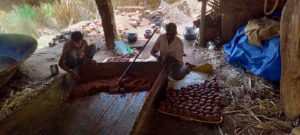
Marayoor jaggery. Photo: K A Shaji
Kanthalloor farmers specialise in terrace farming: They are experts in easily carving steps out of the hilly slopes and making just enough space to cultivate crops, so the village looks mostly similar to Himalayan villages.
The proximity to famous tourist destinations like Munnar, Pattiseri Dam, Anaimudi Sholai National Park, stunning viewpoints, and Keezhanthoor waterfalls also lend value to Kanthalloor as a tourist destination.
The tranquil weather, the lush landscape and the calm locale have endeared Kanthalloor to travellers. So far, it has yet to be touched by commercial tourism.
Tourists who are fond of photography would love Kanthalloor during rainy days. The whole village takes an enticing form after the showers, giving photographers numerous choices to capture the distinct images of Kanthalloor.
Being a languid hamlet tucked away in the Western Ghats, Kanthalloor also holds a lot for adventure enthusiasts.
Trekking through the forests surrounding Kanthalloor is one of the activities that gives backpackers an adrenaline rush.
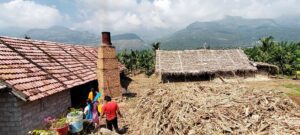
A jaggery processing unit in Marayoor. Photo: K A Shaji
The megalithic Muniyara dolmens are burial chambers subjected to much research by anthropologists. These prehistoric burial sites are an added attraction to the locality.
Kanthalloor’s scenic beauty has always fascinated Malayalam filmmakers, with Sathyan Anthikkad and Blessy portraying it vividly in Rasathanthram and Brahmaram, respectively.
Most Kanthalloor and Marayoor farmers are settlers who made their way to this once-forlorn land for greener pastures.
They tilled the fertile virgin soil, planted and reaped to turn it into the proverbial land of milk and honey that it today is.
Visitors have to pay a small fee to access the farms and their produce. The place never disappoints, for visitors return loaded with ripe golden mangoes, oranges, apples and passion fruit.

Jul 26, 2024

Jul 26, 2024

Jul 25, 2024

Jul 25, 2024

Jul 25, 2024

Jul 24, 2024